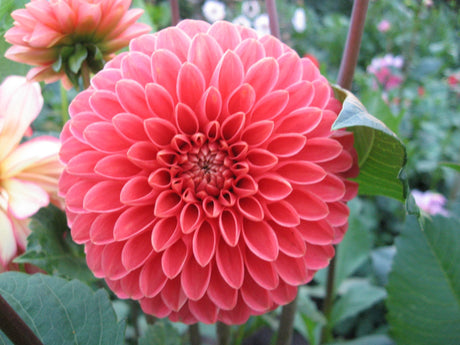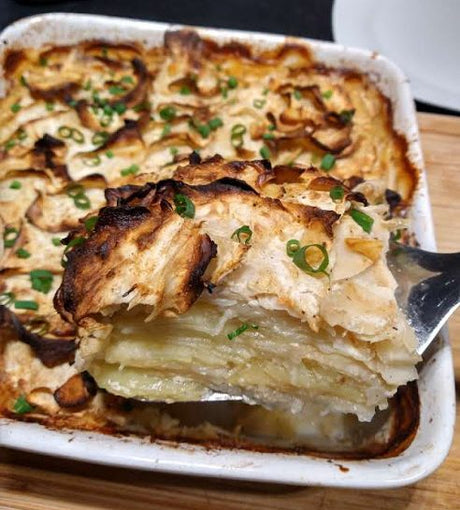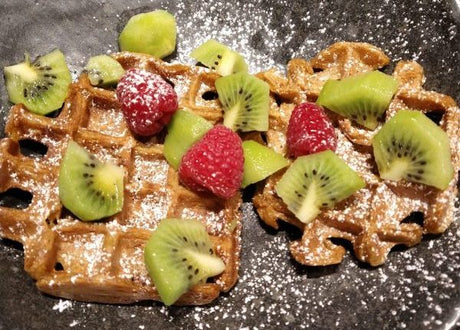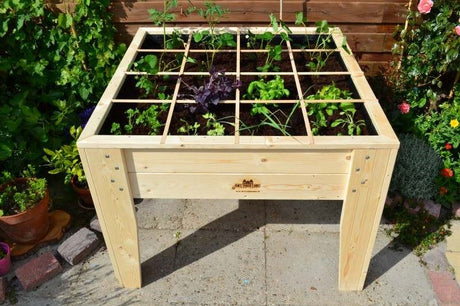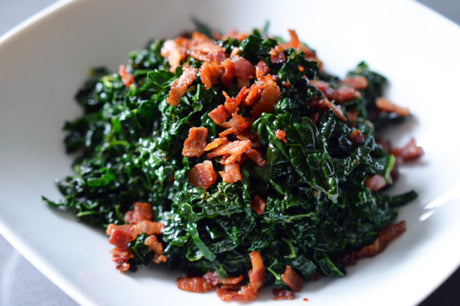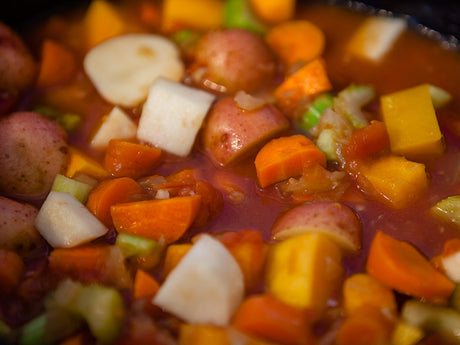Quick start ⚡ Quick start info for sowing peas ⚡
🌱 Sowing & planting
- Sowing depth: 2 cm
- Sowing distance: 60 cm (low varieties) to 80 cm (tall varieties) between rows, 5 cm between plants
- Germination: 5-24 °C, 7-14 days (in dry weather: soak the peas overnight; do not do this in wet weather due to rot)
- Planting distance: 60 cm (low varieties) to 80 cm (tall varieties) between rows, 5 cm between plants
- Plant out as: plants 20 cm high
- Growth cycle: 60-70 days after planting out
📅 Growing times throughout the year
- Pre-grown: sow under glass mid-January-February, plant outdoors late February-early April, harvest late May-June.
- In situ: sow outdoors March-April, harvest end of June-July.
📘 Basic information
- Crop group: Legume
- Plant family: Pea family
- Height: 60-180 cm
- Growth cycle: 60-70 days after planting out
- Frost resistant: yes
- Root system: 45-60 cm
- Preferred soil: pH 6.0-7.5
- Fertilization: no additional fertilization
🌞💧 Pitch & water
Location: 🌞 lots of sun
Watering: 💧 little water needed
🤝 Good & Bad Neighbors
Good neighbors
- Radish
- Spinach
- Corn
- Root
- Caraway
Bad neighbors
- Onion
- Garlic
- Gladioli
- Grape
❗ Dangers & Concerns
- Few specific dangers and concerns known.
🧺 Harvesting & storing
You harvest peas when the pods become round.
Harvest a pod regularly to check whether the peas are nice and round.
🍽️ Nutritional value
Per 100 g cooked peas without salt:
- 84 kcal
- 0 g fat
- 16 g carbohydrates
- 5 g protein
- 5 g fiber
- 6 g sugar
- Vitamins: A, C and K
- Other: folic acid, iron, thiamine and manganese
Quick start ⚡ Quick start info for sowing snow peas or snow peas ⚡
🌱 Sowing & planting
- Sowing depth: approximately 2 cm.
- Sowing distance: 60 cm (low varieties) to 80 cm (tall varieties) between rows, 5 cm between plants.
- Planting distance: equal to the sowing distance: 60–80 cm between rows and 5 cm between plants.
- Germination temperature & germination time: 5–24°C, germinates in about 7–14 days. In dry weather, you can soak the peas overnight to gain time; avoid this in wet weather to prevent rot.
- Planting out: Plant out pre-grown plants when they are about 20 cm tall.
- Growth cycle: approximately 60–70 days.
📅 Growing times throughout the year
- Pre-grown: sow under glass from mid-January to February, plant out outdoors from late February to early April, harvest from late May to mid-June.
- Sowing in situ: sow outdoors from March to early May, harvest from early June to early July.
📘 Basic information
- Crop group: legumes.
- Plant family: Legume family.
- Height: approximately 60 to 180 cm.
- Growth cycle: approximately 60–70 days.
- Frost resistant: yes.
- Root system: root depth approximately 45–60 cm.
- Preferred soil: pH between 6.0 and 7.5.
- Fertilization: no extra fertilizer required.
🌞💧 Pitch & water
Location: ☀️ moderate sun.
Watering: 💧 Water sparingly, especially during dry periods.
🤝 Good & Bad Neighbors
Good neighbors
- Radish
- Corn
- Root
- Caraway
Bad neighbors
- Onion
- Garlic
- Gladioli
- Grape
❗ Dangers & Concerns
Few specific problems are known for snow peas. However, be aware of common fungal diseases during prolonged wet weather and avoid overwatering to prevent seed rot.
🧺 Harvesting & storing
Harvest snow peas young, when the pods are flat and tender. You can also leave them on the plant longer so the peas swell inside the pod and can be eaten.
Fresh snow peas are best stored briefly in the refrigerator. For longer storage, you can blanch and freeze them.
🍽️ Nutritional value
100 grams of cooked snow peas without salt contains approximately:
- Energy: 52 kcal
- Fat: 0 g
- Carbohydrates: 9 g
- Protein: 4 g
- Fiber: 3 g
- Sugars: 5 g
- Vitamins: A, B6, C and K
- Minerals & other: riboflavin, folic acid, pantothenic acid, calcium, magnesium, phosphorus, potassium, iron and manganese
Table of Contents:
growing peas: garden peas, snow peas or snow peas and sweet peas
Many kinds and a drug in the shelling
Growing peas or snow peas is truly incredibly satisfying. There are different kinds of peas, too. With some, we eat the peas themselves, with others the whole pods, and others are simply beautiful to look at and early attractants of beneficial insects. Peas are grown early or late in the year. They thrive in the spring and autumn sun, not the sultry summer sun. They're not only good for your body, but also for your mind. After an hour of popping peas out of their pods, I'm 100% zen. So calm that my glass of white wine usually stays half full (or, for the pessimists, half empty) and the trance of shelling completely takes over. Anyone who's ever shelled peas will certainly know the feeling.
Your first outdoor crop of the year is usually peas
Pea seed packets are usually the first rustling sounds in your seed folder or seed box during your vegetable gardening season. As soon as the soil is workable, you can start with your pea seeds. The seeds germinate at around 6°C (43°F). They can survive any snow showers that come, and they'll emerge when the temperature rises. The young plants can withstand a fair amount of frost (-5°C). If it gets colder, you can cover your pea bed with fleece.
3 types of peas for your vegetable garden
There are three common types of peas that are planted in the vegetable garden.
- Pea and: The round balls that we find in elongated spherical pods.
- Snow peas or snow peas: The flat pods containing small peas that we eat whole, both the pod and the mini peas. The very young pods are delicious raw, as Wim Boers taught me.
- Sweet peas: The inedible pods produce the most beautiful flowers, attracting butterflies and bees (especially bumblebees) that will pollinate your fruit crops. Sweet peas are an excellent plant for producing flowers quickly. Marigolds , marigolds , and other flowers take until July to display an abundance of blooms. With sweet peas and sweet peas, you'll have flowers in your garden as early as April.
- There are also some special types of peas, such as the asparagus pea, but this is actually related to the asparagus.
Planning and nitrogen for your follow-up crops
It's best to harvest your peas in June, or at the latest in early July. Sweet peas and sweet peas also won't survive long in the scorching sun. The good news is that peas belong to the legume family and contribute nitrogen to your soil. Nitrogen (N) is very welcome for subsequent crops, such as many autumn and winter cabbage crops, such as late-season broccoli , cauliflower , Brussels sprouts , kale , and more.

sowing peas - You can sow the 3 types in the same way:
Soil preparation for super tasty peas
Give your plants a flying start by adding fresh compost or manure to the bed where the potatoes were planted in the fall of the previous year. This will become your bed for peas and other legumes. Don't work with fresh compost or manure just before sowing. It's still too potent and won't be washed away by the autumn and winter rains. If you still need to start preparing your soil for planting in February to April, use coconut coir or another low-nutrient soil improver and mix it into your vegetable garden bed with a spadefoot . If your vegetable garden has been fed with wheelbarrows of compost for years, you don't need to improve your soil. Soil improver is always recommended for newly planted vegetable gardens.
Vinassekali and bone meal
Peas are much more productive with a handful (30 grams) of vinasse potash (potassium) and bone meal (phosphorus) per square meter. Adding nitrogen is certainly not necessary. Vinasse potash can also be replaced with wood ash from clean, untreated wood. A light dusting of the soil is good, but don't overdo it.
Support your tall breeds
Sweet peas and sweet peas always grow tall. Among garden peas, you have the Mechelse Krombek - Markveroveraar, which reaches 160 cm tall, and among snow peas, you have the Heraut , which also reaches about one and a half meters tall. There are special trellis trellis and support netting to help your tall peas. Chicken wire can also be helpful.
Sowing or pre-sowing peas
Three crops of peas
There are three crops: one crop that you start under glass and two crops in open ground:
- Pre-sowing under glass: Sow under glass mid-January-February; plant outdoors end of February-beginning of April; harvest end of May-June
- In open ground: Sow outdoors March-April; harvest end of June-July
- Autumn cultivation: Sow outdoors in September when the days are already slightly cooler; harvest from mid-October to mid-November.

General information about sowing peas
It's best to soak pea seeds for 12 hours beforehand; this will help them germinate more quickly, especially in drier soil. It's best not to soak them during wet periods to prevent rot. Sow your seeds 2 to 3 cm deep. In heavy clay soil, it's better to sow 2 cm deep, and in sandy soil and seed-starting mix ( trays ), it's better to sow 3 cm deep. Planting distances for peas are 5 cm between plants in the row, and between rows, leave 30 cm for short varieties ( Wonder van Kelvedon ) and 60 cm for tall varieties ( Mechelse Krombek - Marktveroveraar).
Pre-sowing under glass
If you're sowing under glass, use deep root trays or deep trays for deep root development. These 9 or 12 cm deep trays are ideal for peas. Peas develop a deep root system very quickly. The special trays with vertical grooves prevent the roots from twisting and suffocating your plants. Place your trays in a planter or Danish tray, so you can water and drink from the bottom; the most natural way. You don't need to feed unless you're keeping them in trays for a longer period due to waterlogged clay soil (see later in this growing guide).
Sow in situ in open ground
I often sow two peas per hole. You can also put one in each hole, but I like to play it safe; the strongest will prevail. We plant peas when it's still cold. Ideally, as early as possible outdoors, late February/early March, and from mid-January under glass. If you sow directly in the open ground, your pea seeds can tolerate a layer of snow, even after they've just germinated. But if the snow persists for too long or the temperature drops below 5 degrees Celsius, be prepared for a second sowing. If your spring open-field crop fails, you get a second chance in the fall. While autumn crops aren't as productive, they can still yield a good harvest even after many vegetables have disappeared from the garden.

Sleeping peas
Damp soil or snow in spring
Note! If you have waterlogged soil throughout the spring, consider soaking in pots or a raised bed. Sowing in waterlogged soil will cause your pea seeds to rot. If your soil dries out sufficiently by early spring, you can sow in a deep root tray 9 or 12 cm deep, depending on how long your soil remains too wet. If you have very clay soil, you can also consider the 15 cm deep deep root trays . In that case, mix 3/4 seed and cutting mix with 1/4 potting soil for vegetable gardens. This way, your seedlings will still have some potassium and phosphorus to survive on if they have to stay in the tray longer. They can then start their last growth spurt in the open ground before harvest. A few more pea tips
- Water sparingly, but don't overdo it. Their deep root systems allow the plants to draw water from deep within the soil. Only when you can no longer detect moisture with your index finger in the soil should you water vigorously. If it doesn't rain and you don't water, and your plants become water-stressed, the pods will remain empty and they will die.
- Keep your soil weed-free, so weed or lay a layer of mulch between your plants. It's best to use well-rotted compost .
- Be sure to practice crop rotation with peas . Don't grow them in the same spot every year. Furthermore, the plants that follow benefit from the nitrogen that peas , like most leguminous crops (french beans and broad beans, for example), produce.
Note! If you have waterlogged soil throughout the spring, consider soaking in pots or a raised bed. Sowing in waterlogged soil will cause your pea seeds to rot. If your soil dries out sufficiently by early spring, you can sow in a deep root tray 9 or 12 cm deep, depending on how long your soil remains too wet. If you have very clay soil, you can also consider the 15 cm deep deep root trays . In that case, mix 3/4 seed and cutting mix with 1/4 potting soil for vegetable gardens. This way, your seedlings will still have some potassium and phosphorus to survive on if they have to stay in the tray longer. They can then start their last growth spurt in the open ground before harvest. A few more pea tips
- Water sparingly, but don't overdo it. Their deep root systems allow the plants to draw water from deep within the soil. Only when you can no longer detect moisture with your index finger in the soil should you water vigorously. If it doesn't rain and you don't water, and your plants become water-stressed, the pods will remain empty and they will die.
- Keep your soil weed-free, so weed or lay a layer of mulch between your plants. It's best to use well-rotted compost.
- Be sure to practice crop rotation with peas. Don't grow them in the same spot every year. Furthermore, the plants that follow benefit from the nitrogen that peas, like most leguminous crops (french beans and broad beans, for example), produce.
Diseases and threats to your peas
Harvesting and storing peas
Harvesting sweet and fragrant peas
We don't harvest sweet peas or sweet peas to eat them, of course. You can, however, harvest the dried pods that emerge from the flowers to use the seeds for next year. In that case, store them in a cool, dry place. Wait until the pods are completely dry before storing them.

Harvesting peas - You can feel it
To know when you can pick peas, you can feel the pods. If you can still easily press the pod, it's best not to harvest yet. When you feel a good tension on the pod, it's time to start harvesting. When you start to see the shape of the peas through the pods, that's a sign that your pods are too large and losing their flavor. Another reason to pick as soon as you feel resistance on the pod is that picking peas stimulates growth and flowering! in the plant. I always harvest my peas in three harvests. With taller varieties, you start harvesting at the bottom. The peas that grow higher are usually not ready. Harvest a pod regularly, feel it first, and see how big the peas are; that way, you'll become a true expert. Also count your peas; if you have 5 or fewer peas in a pod, your harvest wasn't optimal. If you have 6 or more peas per pod of equal size, you've done well. You can tell by the size of your peas in your pod whether they have experienced periods of drought.
If you harvest a pod with nine peas, according to a vegetable garden legend, you will experience happiness in the vegetable garden for a whole year.
Harvesting snow peas
Snow peas, or snow peas as they're often called, are harvested by sight. The snow peas , about 3 to 5 centimeters long, are delicious raw. You can season them with salt and pepper and add them to sandwiches or salads with a little olive oil or yogurt sauce. Harvest the snow peas before the peas start to grow; otherwise, they'll become tough and less enjoyable. Snow peas are delicious in Asian cuisine, but also simply in a makeshift wrap or with potatoes and sausage. You can prepare them a bit like green beans. I like to stew a shallot; when it's nice and translucent, add the snow peas and cook them briefly. Then I deglaze my pot with water and white wine vinegar and cook the snow peas for another 5 minutes. The fresher and younger the snow peas, the shorter the cooking time. Don't overcook them, or they'll lose their bite. Adding a sprig of trimmed thyme or savory also works wonders. Some freshly chopped mint is also delicious. Seriously! It makes my mouth water.
Harvest your peas in the morning
Pick your peas and snow peas in the morning. After the dew has dried, they're in peak condition. Store them in a cool place right away. You can easily shell peas in the evening or later, just don't wait too long. Anything I don't eat between May and early July I freeze raw. I don't blanch the peas. I don't store them for very long; they quickly end up in paella or as a side dish for a summer barbecue.
Harvest your peas without damaging the plant
Don't just pull the pods off the plant. Damaging the plant can significantly reduce your harvest. Hold the plant with one hand and pick the pod with the other. You can also use harvesting shears to cut off the pods. This last method might be the best.
Dried peas for soup
Suppose a trip, illness, or forgetfulness causes you to completely forget about your peas . You can still harvest them and save them for a delicious soup. A few handfuls of dried peas in a winter soup will warm you up completely before or after a brisk walk outside or some pruning in your garden.

Sweet peas or sweet peas Our recommended varieties:
- Peas :
- Low (bush peas) without support: Charmette (extra fine and extra sweet to eat stewed with or without carrots), Eminent and Karina BIO (the latter two less sweet and more suitable for soup)
- Low with support 60 cm: Wonder of Kelvedon (super productive variety for all preparations, place gauze or support net at a height of 50 cm).
- Medium height with support 100 cm: Senator (even more yield for all preparations)
- High with support up to 160 cm: Mechelse Krombek - Market conqueror (the most productive for all preparations)



